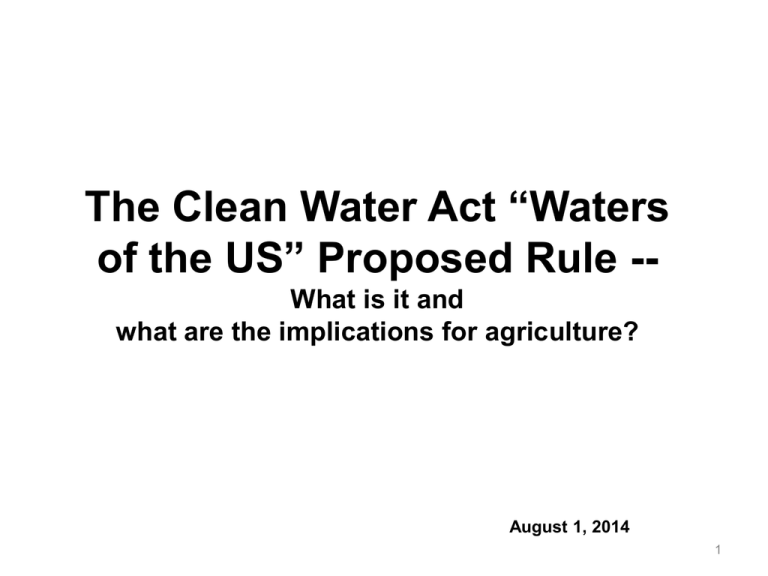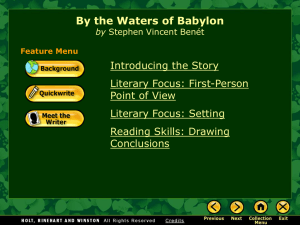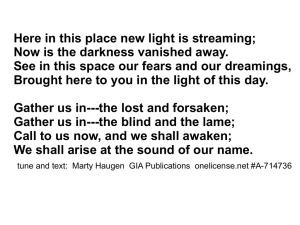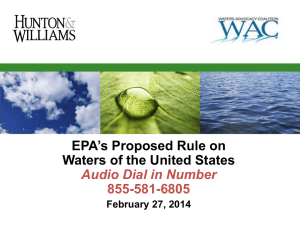NCFC_on_WOTUS_2 - United Producers, Inc.
advertisement

The Clean Water Act “Waters of the US” Proposed Rule -What is it and what are the implications for agriculture? August 1, 2014 1 Acronyms and Terms Agencies Environmental Protection Agency & U.S. Army Corps of Engineers CWA Clean Water Act WOTUS “Waters of the U.S.”, those waters under the jurisdiction of the CWA Rule The Agencies’ proposed WOTUS rulemaking FEMA Federal Emergency Management Agency USGS US Geological Survey Agencies’ WOTUS Rule • Proposal published in Federal Register on April 21, 2014 – https://www.federalregister.gov/articles/2014/04/2 1/2014-07142/definition-of-waters-of-the-unitedstates-under-the-clean-water-act • Comments are due on October 20, 2014 – Email: ow-docket@epa.gov. Include EPA-HQ-OW-20110880 in the subject line of the message. – Mail: Send original & 3 copies to: Water Docket, USEPA, Mail Code 2822T, 1200 Pennsylvania Avenue NW., Washington, DC 20460, Attention: Docket ID No. EPA-HQOW-2011-0880 3 Why a Rule Now? • Over last 30 years the Agencies have claimed broad jurisdiction, using expansive interpretations of the non-navigable waters that are subject to CWA • Many of those expansive interpretations have never been spelled out in a formal rulemaking • Two Supreme Court decisions (2001 & 2006) involving wetlands – Told the Agencies their wetlands interpretations were too broad – Signaled that their interpretations involving streams and ditches with less than permanent flow were too broad – Indicated that a not insubstantial and more than speculative finding of a “significant nexus” between remote wetlands, streams/ditches on one end and permanent flowing waters on the other could, under certain circumstances, make the remote waters WOTUS – Indicated a rulemaking was needed. • This proposed rule is a response to this situation 4 What Does the Rule Do? • Restates that navigable waters are WOTUS • Defines in rulemaking for the first time, and make WOTUS – Tributaries, no matter how limited their flow of water or how remote they are; – Numerous ditches found in common circumstances • Defines “adjacent” wetlands and waters, including those in “floodplains” and “riparian zones” • Creates a case-by-case significant nexus test for remote waters and wetlands – the so-called “other” waters. 5 What is a WOTUS Under the Rule? • • • Courts have said the CWA covers waters that are navigable and certain non-navigable waters; the law doesn’t define the latter. The Agencies have interpreted which of the non-navigable waters are WOTUS. The rule defines WOTUS as: – Coastal waters and territorial seas; – Rivers and lakes; – Tributaries that reach the above waters (including many ditches with requisite characteristics); – All “impoundments” of the above; – Waters or wetlands that are “adjacent” to, and have some type of water connection, with any of the above; and – On a case-by-case basis, “other” waters or wetlands that are isolated and don’t fall into one of the categories above, but alone or in combination with similar waters have a significant nexus to the above. 6 What Does the Rule Exclude From Jurisdiction? • Prior converted cropland – PC’s are determined by USDA-NRCS under Swampbuster – But the Agencies state that they retain right to make a different CWA determination. • Two types of ditches (1) those ditches that are excavated wholly in uplands, drain only uplands, and have less than permanent flow, and (2) those ditches that do not contribute flow, directly or indirectly through waters, to a WOTUS. other • Tile drains • Waste treatment systems • Farm and stock ponds and settling basins that are excavated in uplands and collect surface runoff – Farm and stock ponds are WOTUS if they are created by impounding any size of stream • Artificial irrigation areas in land that would return to upland if irrigation ceases • Gullies, rills and non-wetland swales 7 What Are “Tributaries?” • A feature is a tributary if – It is a natural or manmade channels; – Has a discernible bed, bank and ordinary high water mark – Has any flow in it for any length of time • Year-round, the “perennial” tributaries • Seasonally, the intermittent tributaries • Only when it rains, the ephemeral tributaries – And it contributes flow to another water through a surface or subsurface connection • Includes rivers, streams and, subject to certain conditions, ditches 8 WOTUS Tributaries in West Central Ohio – National databases can map some but not all tributaries. This is from USGS data. The blue/red lines are perennial, intermittent or ephemeral streams. But clearly visible beyond the mapped streams are additional, unmapped tributaries. All of these tributaries are WOTUS. The yellow hatched area is a FEMA 100 year floodplain (more on this later). Source: Agricultural Nutrients Policy Council map prepared by Geosyntec 9 Drainage in Illinois Corn Field – Drainage features such as this in an Illinois corn field drain off spring rains and can create tributary features like those seen in the previous slide which meet the WOTUS definition even if they are not identified in the national databases. Which Ditches Are Jurisdictional? • Ditches that drain a WOTUS • Ditches in upland area that flow permanently • Ditches not in upland areas – The rule does not define upland – EPA science document defines upland as not in a wetland or floodplain • Ditches created through improvement of a stream 11 Ditch in floodplain (non-upland), WOTUS Former (ephemeral) stream, improved for drainage, WOTUS 13 What Does “Adjacent” Mean? • Adjacent means bordering, contiguous or neighboring, and includes waters and wetlands separated from WOTUS by dikes , berms, and dunes • Neighboring means waters located in riparian area or floodplain of a WOTUS, or waters with a shallow subsurface or confined surface hydrologic connection to WOTUS • Riparian area means area bordering a WOTUS where surface or subsurface water influence plants and animals in that area • Floodplain means area bordering WOTUS where sediment is deposited through inundation during periods of moderate to high water flows. 14 Floodplains in West Central Ohio – The rule asks for comments on how to precisely define a floodplain. In this map, the yellow hatched areas represent an estimate of floodplain for the rule using FEMA 100 year floodplain data, and the white areas are estimates for those tributaries that haven’t been mapped by FEMA, using a 35 foot buffer. Wet areas, wetlands, ditches, in the floodplain are WOTUS. Source: Agricultural Nutrients Policy Council map prepared by Geosyntec 15 Riparian area in S. New Jersey – Waters in a riparian area that is hydrologically connected to a WOTUS are themselves WOTUS. These marked features may also be impoundments of an ephemeral or intermittent stream, which also would make them WOTUS under the rule. Source: Base map from the USDA-NRCS web soil survey 16 How Do Remote Wetlands and Waters Become WOTUS? • These “other” remote waters and wetlands become WOTUS if, on a case-specific basis, they have a significant nexus with the other WOTUS; • The remote waters or wetlands are evaluated in combination with other similarly situated waters or wetlands located in the same region; • Significant nexus means these remote waters significantly affect the chemical, physical, or biological integrity of the downgradient WOTUS 17 Isolated Wetlands Wetlands in South Dakota. Do these, alone or in combination with others that are similarly situated in the area, have a significant nexus to relatively permanent flowing waters downstream? Source: Agricultural Nutrients Policy Council image from maps prepared by Geosyntec 18 Existing CWA Exemptions Apply • Section 404(f) normal farming, ranching and silviculture activities still exempt • Normal ditch maintenance is exempt • Agricultural stormwater discharges are exempt • Irrigation return flow discharges are exempt 19 What Are Agriculture’s Major Concerns & Why? 20 Jurisdiction Claimed is Too Broad! After two Supreme Court decisions, how can Agencies claim so many features as WOTUS? Iowa tributaries from USGS database (perennial + intermittent waters) Iowa tributaries from USGS (perennial + intermittent + ~ 35% of ephemeral waters) + FEMA 100 year floodplain Source: Agricultural Nutrients Policy Council map prepared 21 by Geosyntec Rule Creates More Uncertainty There are literally millions of open questions in farm country to be answered by Agency personnel – are these WOTUS? 22 More Section 404 Problems • More drainage features being jurisdictional means either – More Army Corps 404 permitting – More Agency challenges in the field to normal farming activities “This regional general permit with authorize the discharge of fill materials into waters of the US in the upper reaches of watersheds.” 23 Suits Leading to NPDES Permitting for Row Crops • CWA citizen suits have resulted in aquatic pesticides needing NPDES permits • Under this rule, citizen suits would call for NPDES permits for the normal use of fertilizers and pesticides around dry drainage features that would now be WOTUS 24 Isn’t the CWA About Waters that are Fishable and Swimmable? We can work together to reduce losses of nutrients and sediments to protect quality of valuable waters. Drainage features like these will never be fishable or swimmable, and don’t need that designation to protect downstream waters. 25








